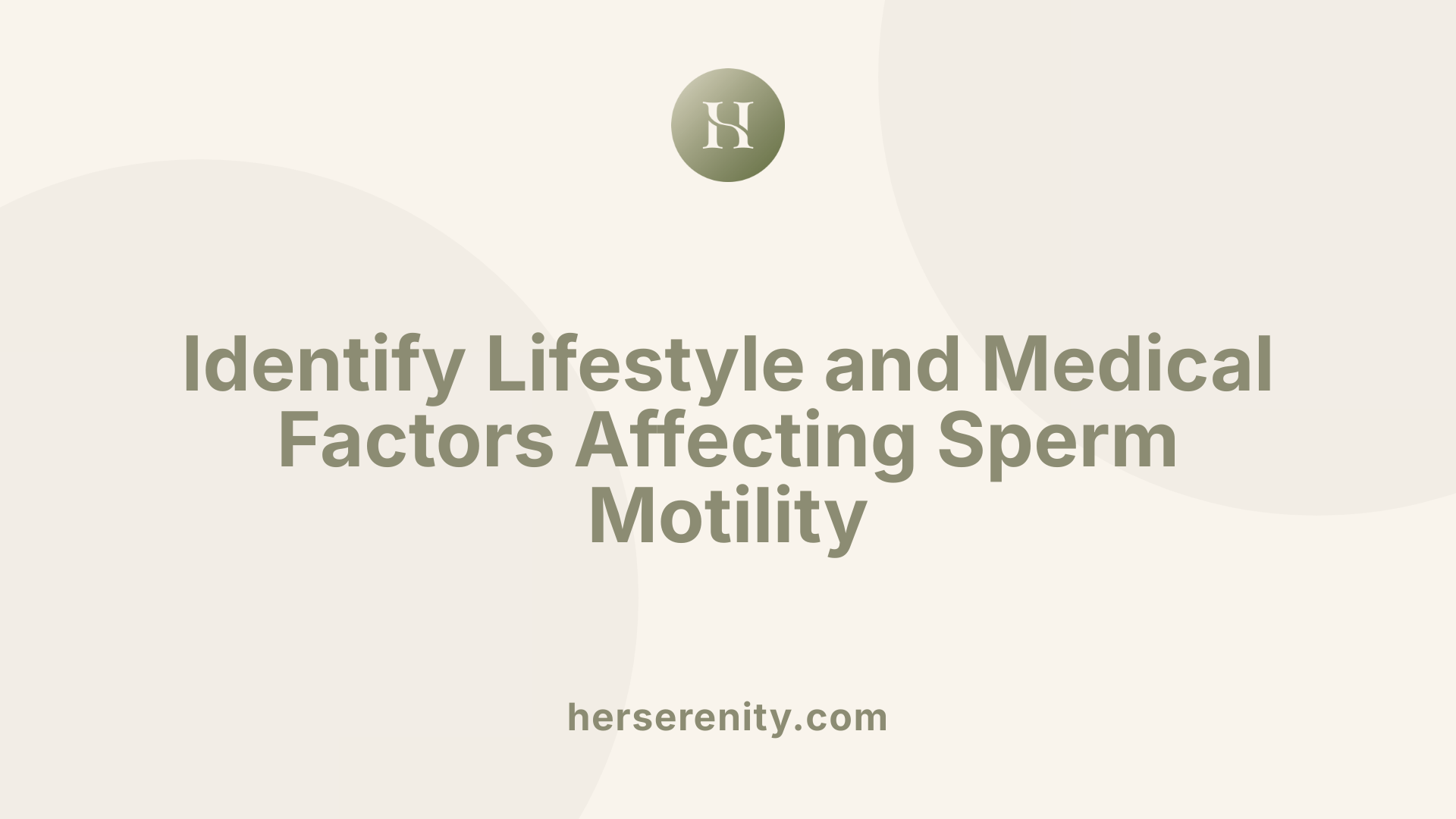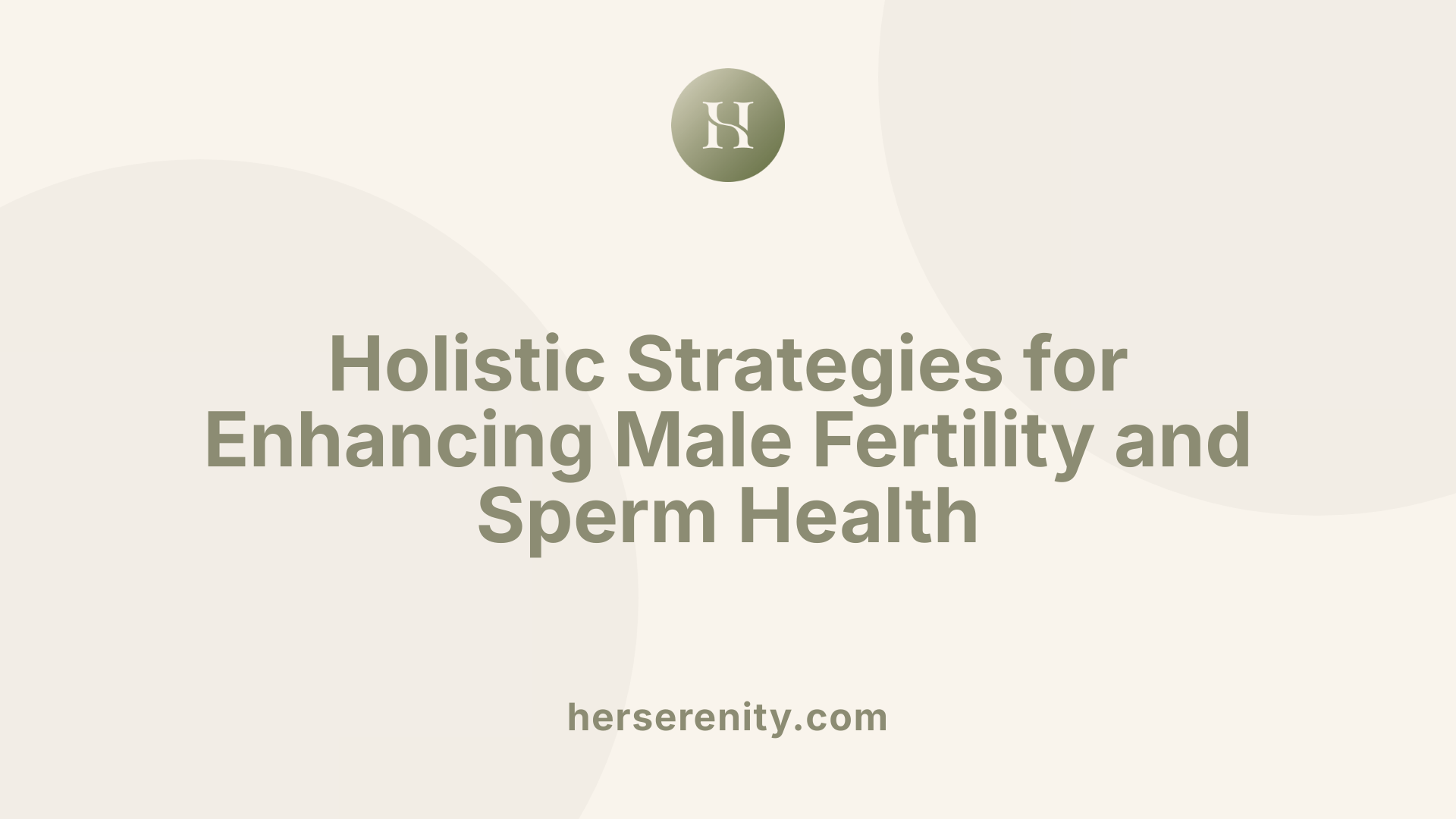Introduction to Male Fertility and Sperm Motility
Male fertility relies heavily on the health and function of sperm, with motility— the ability of sperm to move efficiently—serving as a key determinant of fertilization success. This article explores the vital role sperm motility plays in natural conception and assisted reproductive technologies, the factors that influence it, and medical advances designed to assist men struggling with impaired motility.
Fundamentals of Sperm Health: Count, Motility, and Morphology
What is sperm motility and why is it important for male fertility?
Sperm motility is the ability of sperm to move and swim efficiently. This movement is crucial because sperm must travel through the female reproductive tract to reach and fertilize the egg. Without adequate motility, sperm may fail to reach the oocyte, reducing the chances of successful conception.
Sperm count and morphology as complementary factors
Alongside motility, sperm count and morphology play vital roles in male fertility. A healthy ejaculate typically contains at least 15 million sperm per milliliter to maximize fertilization chances. Morphology refers to the shape of sperm, with normal sperm having oval heads and long tails. A higher proportion of normally shaped sperm is linked to better fertility outcomes.
WHO standards for normal sperm motility
The World Health Organization (WHO) defines normal sperm motility as having over 40% of sperm motile. Specifically, at least 32% should exhibit progressive motility—meaning they swim mostly in a straight line—and about 12% should move quickly in a straight path. Meeting these benchmarks is associated with improved fertilization potential and natural pregnancy success.
Assessment of Sperm Motility in Fertility Evaluation
What are the Parameters of Semen Analysis Related to Motility?
Semen analysis is a foundational test in male fertility assessment. Among various parameters, sperm motility is critically evaluated. It includes both the percentage of motile sperm and the quality of their movement, often classified as progressive or non-progressive.
What Criteria Define Normal and Poor Sperm Motility?
According to the World Health Organization (WHO) 5th edition criteria, normal sperm motility involves at least 40% of sperm exhibiting motile behavior. Specifically, 32% should demonstrate progressive motility, meaning they swim in a straight line or large circles, which is essential to reach and fertilize the egg. Rapidly progressive sperm should comprise about 12%. Poor motility, known as asthenozoospermia, is diagnosed when less than 32% of sperm are motile, significantly lowering fertility potential.
How Does Sperm Motility Impact Fertility Diagnosis?
Sperm motility is a key factor for fertilization success. Declines in motility impair the sperm's ability to traverse the female reproductive tract and fertilize the oocyte. Reduced motility levels often prompt further diagnostic efforts to find underlying causes such as hormonal imbalances, anatomical abnormalities, or lifestyle factors.
How Do Medical Professionals Determine the Appropriate Fertility Treatment for an Individual or Couple?
Fertility specialists assess sperm motility along with other factors to inform treatment decisions. When motility is below 40%, further hormone testing and physical examinations are undertaken to identify actionable causes. Treatments may range from lifestyle modifications and antioxidants to more advanced options like surgical repair of varicoceles or assisted reproductive technologies (ART) such as intrauterine insemination (IUI) or in vitro fertilization (IVF) with intracytoplasmic sperm injection (ICSI) for severe cases.
This comprehensive evaluation ensures that interventions are tailored to the individual's specific fertility profile, optimizing chances of conception.
Common Causes and Risk Factors for Impaired Sperm Motility

Lifestyle and Environmental Factors
Lifestyle choices have a significant impact on sperm motility and overall male fertility. Maintaining a healthy weight and managing stress are foundational to supporting reproductive health. Avoiding smoking and limiting alcohol intake are crucial, as both can damage sperm quality. Additionally, reducing exposure to environmental toxins helps prevent adverse effects on motility. Preventing sexually transmitted infections (STIs) also plays a vital role in preserving sperm function.
Medical and Anatomical Conditions Affecting Motility
Certain medical conditions can impair sperm motility. Varicocele, an enlargement of veins in the scrotum, is notably linked to reduced sperm movement and affects a significant proportion of men with fertility issues. Surgical repair, such as varicocelectomy, has proven effective in improving motility and increasing pregnancy rates. Other factors include testicular damage from infections, cancer, or injuries, which can hamper sperm production and movement. Genetic abnormalities like Y chromosome microdeletions and structural defects in sperm flagella can also disrupt motility.
Impact of Toxins, Heat, and Medications
Exposure to toxins, whether occupational or lifestyle-related, such as heavy metals and some recreational drugs, negatively impacts sperm motility. Certain medications, including chemotherapy and some hormonal or recreational drugs like anabolic steroids and cocaine, also contribute to reduced sperm quality. Excessive heat exposure to the scrotum—caused by factors such as tight clothing or prolonged hot baths—can diminish sperm motility by affecting the delicate environment required for healthy sperm development.
What lifestyle changes can support reproductive health and improve the chances of conception?
Maintaining a healthy weight, avoiding smoking and excessive alcohol consumption, managing stress, reducing toxin exposure, and preventing sexually transmitted infections are key lifestyle changes that support sperm health and improve motility.
Molecular and Cellular Mechanisms Underpinning Sperm Motility
What is the axoneme structure and its role in sperm motility?
The axoneme is the core structural component of the sperm tail that enables its movement. It features a 9+2 microtubule arrangement, meaning nine pairs of microtubules surround two central microtubules. Dynein arms attached to these microtubules act like motor proteins, generating the sliding forces that propel the sperm forward. Defects or mutations in genes coding for axonemal proteins, such as DNAH5 and DNAI1, disrupt this structure and result in impaired motility, a condition known as primary ciliary dyskinesia.
How do ions like calcium and bicarbonate regulate sperm motility?
Calcium ions (Ca2+) and bicarbonate ions (HCO3−) play crucial roles in activating sperm motility. Optimal concentrations of Ca2+ and bicarbonate trigger signaling pathways inside sperm cells that elevate cyclic AMP (cAMP) levels. This increase promotes protein phosphorylation, which enhances flagellar beating and motility. However, both excessively high and low calcium levels can inhibit movement, underscoring the importance of precise ion balance for optimal function.
What roles do signaling proteins and membrane components have in motility?
Sperm motility is also influenced by surface molecules such as lipids and membrane proteins. These components regulate membrane fluidity and facilitate cell signaling essential for controlling movement. Proteins like forward motility-stimulating factor (FMSF) and motility-stimulating protein (MSP) activate intracellular pathways involving cAMP and protein kinases, amplifying the sperm’s motility. By modulating these signals, sperm cells can adjust their swimming patterns to successfully reach and fertilize the egg.
Medical and Surgical Treatments to Improve Sperm Motility

What are the most common medical treatments available to assist individuals and couples with conception?
Improving sperm motility can involve a combination of lifestyle changes, medical therapies, and surgery. Lifestyle modifications are foundational; maintaining a healthy weight, quitting smoking, moderating alcohol intake, managing stress, and avoiding environmental toxins all support sperm health.
Antioxidant therapy has shown promise in enhancing sperm motility. Supplements such as coenzyme Q10, vitamin C, and vitamin E may improve semen parameters by reducing oxidative stress—one factor that impairs sperm movement.
Hormonal treatments can be prescribed to optimize the hormone balance necessary for sperm production and motility. Medications like clomiphene, tamoxifen, and aromatase inhibitors are sometimes used off-label to address idiopathic infertility or hormonal imbalances, potentially improving sperm motility.
Surgical intervention is particularly effective when anatomical issues impact sperm quality. Varicoceles—enlarged veins in the scrotum—affect a significant proportion of men experiencing infertility and can reduce sperm motility. Microsurgical varicocelectomy repairs these veins, often resulting in notable improvements in sperm count, morphology, and motility.
Other surgeries may target obstructions or cysts that impair sperm transport.
In summary, a tailored approach combining lifestyle adjustments, antioxidant or hormonal treatments, and surgery like varicocele repair can significantly enhance sperm motility. These interventions improve the chances of conception either naturally or via assisted reproductive technologies when necessary.
Assisted Reproductive Technologies (ART) and Sperm Motility Challenges
How do assisted reproductive technologies (ART) improve the chances of conception?
ART methods like in vitro fertilization (IVF) and intracytoplasmic sperm injection (ICSI) provide valuable solutions for couples facing male infertility due to poor sperm motility. IVF involves fertilizing eggs outside the body, where sperm and eggs meet in a controlled laboratory setting. However, when sperm motility is severely compromised, simply mixing sperm and eggs may not result in successful fertilization.
ICSI directly addresses this challenge by injecting a single sperm cell directly into the egg cytoplasm. This technique bypasses the need for motile sperm to reach and penetrate the egg, greatly enhancing the chances of fertilization even when sperm motility or count is extremely low.
IVF and ICSI Techniques
- In Vitro Fertilization (IVF): Eggs are collected and placed with sperm in a culture dish to allow natural fertilization.
- Intracytoplasmic Sperm Injection (ICSI): A single sperm is selected and injected into the egg, useful when sperm motility or morphology is poor.
How ART Overcomes Low Sperm Motility
Low sperm motility hinders the sperm's ability to traverse the female reproductive tract and reach the egg. ART, especially ICSI, circumvents this natural requirement by manually facilitating fertilization. This is crucial for men with asthenozoospermia or other motility impairments caused by lifestyle factors, genetic issues, or medical conditions.
Success Rates and Considerations
ART success depends on factors such as the woman's age, egg quality, and the severity of sperm impairment. Meta-analyses show that men with severe motility problems who undergo ICSI achieve fertilization and pregnancy rates significantly higher than with natural conception attempts.
Considerations include the need for specialized laboratory skills, potential risks associated with ART procedures, and the emotional and financial costs. However, ART remains a leading treatment for overcoming fundamental sperm motility challenges, offering hope to many couples desiring children.
Potential Risks and Side Effects of Fertility Treatments

What are the potential risks and side effects associated with fertility treatments?
Fertility treatments, while beneficial for many couples, carry certain risks that need careful consideration and management. The use of fertility drugs can lead to side effects like hot flushes, headaches, and nausea. More serious complications include ovarian hyperstimulation syndrome (OHSS), a condition where the ovaries become swollen and painful due to excessive response to fertility medications.
Multiple pregnancies (twins, triplets, or more) are another risk, especially with treatments like in vitro fertilization (IVF) and intrauterine insemination (IUI). Multiple gestations increase the chances of premature birth, low birth weight, and complications for both mother and babies.
Infections can occur due to invasive procedures inherent in some treatments. However, with vigilant medical supervision, such risks are minimized to protect patient safety.
Given these potential risks, it's essential that individuals undergoing fertility treatments do so with professional guidance to balance treatment benefits against side effects and complications.
Emerging Research and Advances in Evaluating and Enhancing Sperm Motility

What Are the New Methods for Assessing Sperm Motility?
Recent advances in sperm motility research focus on improving the accuracy and depth of motility evaluation. Traditional semen analysis measures motility percentages, such as the WHO standard requiring at least 40% motile sperm. However, cutting-edge techniques now include three-dimensional motility analysis, which tracks sperm movement in depth and space rather than just in two dimensions. These methods enable categorization of sperm kinetics based on velocity, linearity, and motion patterns, providing a more detailed picture of sperm swimming behavior.
Which Molecular Targets Are Being Explored for Therapy?
Progress in molecular and biochemical studies has identified several intracellular signaling pathways and structural components crucial for sperm motility. Key targets include the 9+2 microtubule axoneme structure and associated proteins like dynein arms, necessary for flagellar movement. Ion channels regulating intracellular calcium (Ca2+), bicarbonate ions (HCO3−), and cyclic AMP (cAMP) signaling are also critical for activating and sustaining motility. Therapeutic strategies are beginning to focus on modulating these molecular pathways to enhance sperm movement. For instance, proteins such as forward motility-stimulating factors (FMSF) trigger intracellular cascades to promote motility.
Why Is Understanding Hyperactive Sperm Motility Important?
Hyperactive motility describes a vigorous, non-linear swimming pattern that sperm acquire during capacitation, a maturation process essential for fertilization. This hyperactivity helps sperm penetrate the egg's surrounding layers. Understanding the molecular mechanisms and biochemical triggers of hyperactive motility is vital for improving fertility treatments. Therapies that modulate capacitation could enhance sperm's ability to fertilize the oocyte naturally or during assisted reproduction techniques like IVF and ICSI.
These research advances not only deepen understanding of sperm physiology but also open new opportunities for targeted interventions. Emerging assessment tools combined with molecular therapies promise to improve male fertility outcomes by directly addressing motility defects often seen in infertility.
Integrating Lifestyle, Medical, and Technological Approaches for Optimizing Male Fertility

What lifestyle changes can support reproductive health and improve the chances of conception?
Adopting a balanced diet rich in antioxidants, maintaining physical fitness, quitting smoking, moderating alcohol intake, and managing stress are critical to supporting reproductive health. These lifestyle changes have been shown to improve sperm concentration, motility, and morphology — all crucial factors in male fertility. Avoiding toxins and excessive scrotal heat by wearing loose clothing and managing environmental exposures also protect sperm health.
Why is early diagnosis and combining approaches important?
Early diagnosis of male fertility issues allows for timely interventions, potentially increasing the chances of conception. Semen analysis measuring sperm count, motility, and morphology helps identify specific problems. For instance, poor sperm motility often requires a focused treatment plan, including medical or surgical options.
Combining lifestyle modifications with medical treatments, such as antioxidant supplementation or hormonal therapy, can optimize sperm quality. For men with varicocele, microsurgical repair (varicocelectomy) improves sperm parameters and boosts pregnancy rates. Assisted reproductive technologies (ART) like intrauterine insemination (IUI), in vitro fertilization (IVF), and intracytoplasmic sperm injection (ICSI) may be recommended when motility or count remains low despite treatment.
How do holistic methods benefit male fertility?
Holistic fertility support integrates healthy habits with medical advances to enhance reproductive success. This approach reduces oxidative stress and inflammation—known contributors to poor sperm motility—and maximizes sperm function. Ongoing research continues to refine understanding of sperm motility at molecular levels, allowing personalized treatments.
By combining environmental, lifestyle, medical, and technological strategies, men can significantly improve their fertility outcomes. Consulting specialists after one year of unsuccessful conception attempts ensures access to comprehensive evaluation and tailored interventions for better reproductive health.
Conclusion: The Critical Importance of Sperm Motility in Male Fertility
Sperm motility is a cornerstone of male fertility, influencing both natural conception and the success of assisted reproductive technologies. Understanding the biological mechanisms controlling motility, identifying and treating underlying causes, and integrating lifestyle improvements with medical interventions form the foundation of effective fertility management for men. Emerging research continues to expand our ability to evaluate and enhance motility, promising better individualized care. Men facing fertility challenges should seek timely specialist evaluation to benefit from these advances while supporting sperm health through positive lifestyle choices.
References
- Healthy sperm: Improving your fertility
- Male Infertility - StatPearls - NCBI Bookshelf
- Current Insights in Sperm Motility and Male Fertility
- Understanding the Role of Male Sperm Health in Fertility
- The Role of Sperm Motility - Austin Fertility & Reproductive ...
- Diagnosis and Treatment of Infertility in Men: AUA
- Understanding sperm motility mechanisms and the implication ...





